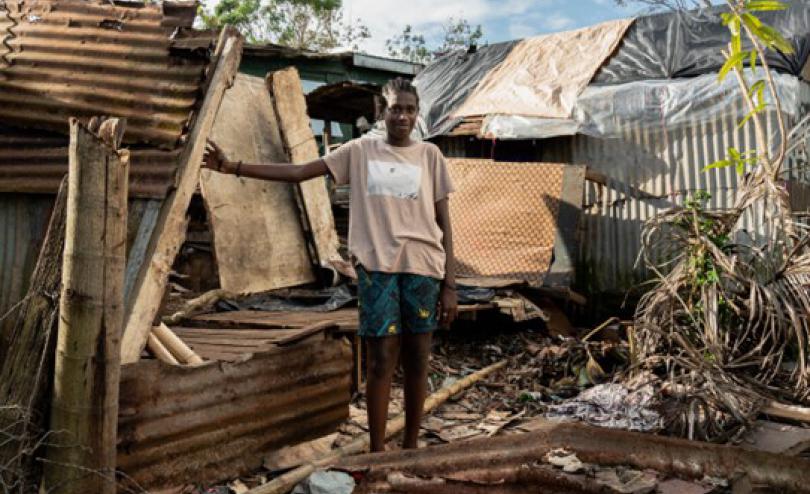Tropical Cyclone Lola has claimed at least two lives – one of them a pregnant woman – and caused widespread damage to hundreds of homes, schools, and food gardens in Vanuatu, the government said on Tuesday.
More than 15,000 students have been impacted, the government said, with the category 5 super storm destroying classrooms across Ambae, Maewo and Pentecost islands.
Vanuatu is still recovering from twin cyclones Judy and Kevin, both category 4 storms that devastated the country in March, Disaster Management Minister Ralph Regenvanu said.
Last week’s storm came “well ahead” of the Pacific’s cyclone season, from November to April, he said.
NGOs warned that damage from all three super storms was extremely severe and had left ni-Vanuatu children even more fearful of what this cyclone season would bring.
Port Vila student Chloe said Cyclone Lola was a “scary experience”.
“We have had three terrifying cyclones this year, and it is not even November yet,” the 14-year-old told Stuff.
“For young people, especially those who have not already experienced cyclones, it can be very scary.
“You know a cyclone is coming and so you just have to sit there and wait for it. Seeing it come closer and closer can be a terrifying experience, but it’s just how life is here, and we can’t escape that.
“One of the hardest things is not being able to contact your family and friends and so you don’t know if they are OK or what the damage has been elsewhere in the country.”
Rachel, 16, said her family’s house was badly damaged during cyclones Judy and Kevin, and they were still repairing it when Lola struck, eight months later.
“We feel so hopeless, helpless, to be honest. You don’t know what to do, where to go or who to ask for help because everyone around you is suffering too.”
Regenvanu said the most heavily impacted areas included Pentecost, Malekula and Ambrym, where it was estimated that 50% of the homes had been damaged.
He said an estimated 80,000 people were “significantly impacted, including 40,000 children”.
The New Zealand, Australian and United Kingdom governments said their relief efforts were under way.
The Ministry of Foreign Affairs and Trade(MFAT) said Kiwis in Vanuatu are safe and assisting those who need help in their communities.
An RNZAF P-8A Poseidon had conducted an aerial surveillance flight on Thursday, 26 October, to support the initial damage assessments.
“Images and reports from this flight were given to the government of Vanuatu,” a spokesperson said, adding that New Zealand’s support was positioned out of the capital, Port Vila.
“Our humanitarian assistance includes a Royal New Zealand Air Force C-130 flight landing in Vanuatu on Monday, October 30, carrying essential humanitarian supplies including shelter kits, mother and infant kits, water, sanitation and hygiene kits, and chainsaw kits.
“A deployment of two experts from New Zealand’s National Emergency Management Agency to assist Vanuatu’s National Disaster Management Office with its response.”
MFAT said there was also funding available for ADRA New Zealand (Adventist Development and Relief Agency New Zealand) to provide relief supplies to impacted communities.
NGOs are also on the ground delivering shelter and hygiene kits to displaced people and setting up child-friendly spaces in the evacuation centres.
Save the Children said at least 100 schools were damaged, including 70 that have either been destroyed or need major repairs.
It is also setting up temporary learning spaces for older students who are due to sit their final exams in the coming weeks, Save the Children Vanuatu country director Polly Banks told Stuff.
“Climate-induced disasters disproportionately impact children and young people, particularly as a result of disruption to education and psychosocial trauma associated with ongoing experiences of intensifying disasters,” she said.
“It is terribly sad that just eight months on from the devastating twin cyclones in March, Vanuatu has now experienced another major cyclone.
‘It has also sadly claimed the lives of two people, including a pregnant woman from Ambrym Island, and destroyed or damaged hundreds of homes and schools.”
Banks said Ni-Vanuatu children were “extremely resilient”, but there was “not enough time” between these cyclones for the children and their families to recover.
She said while Vanuatu had prepared for future climate impacts, which included taking the country’s climate action to the United Nations, ni-Vanuatu children faced the greatest exposure to repeated climate disasters than other children in the world, “so they need all the support they can get”.
“We need to see real commitments from the international community to support Vanuatu and many other climate-vulnerable states around the world, including at COP28 in November.”
Chloe said she is proud of the work Vanuatu is doing to tackle the climate crisis, but warned her tiny island could not do it alone.
She has called on the international community to step up assistance.
“At the end of the day, we are not going to make a significant impact on helping to reduce emissions because we have a minuscule carbon footprint compared to some countries.
“Our contributions won’t change much all by itself,” Chloe said.
New Zealand said there was funding available to support additional requests from the government of Vanuatu.
“We will continue to work closely with our Vanuatu whānau, and consider any further assistance,” the MfAT spokesperson said.
SOURCE: STUFF NZ/PACNEWS














